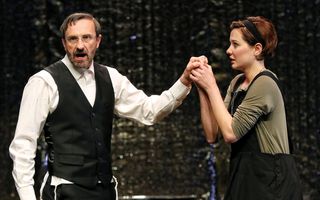 Watch
Watch
After centuries of prosperity and financial freedom under the Norman Kings, all Jews were expelled from England in 1290 by King Edward I who wished to gain favour with the disgruntled public and promote nationalistic sentiment. Jewish citizens were not previously accepted in England, but had lived and prospered somewhat harmoniously. This act solidified the religious divide for the next 300 years.
Vilification of the Jewish faith is rife throughout literary history and folk-lore, and is believed to have been very present in London in the 16th century. Two English plays regarding Judaism that immediately pre-date Shakespeare’s text, The Jew (1570, now lost) and Marlowe’s The Jew of Malta (1589), present their title characters in a stereotypical, grotesque manner, with few redeeming qualities. However, academic Charles Edelman offers an alternative belief that anti-Semitism was not a tradition of English theatre, and notes that Robert Wilson’s 1584 play The Three Ladies of London features a Jewish moneylender as the most honourable character. Either way, it is a fact that there was a very small number of Jews living in London at this time, and it is important to consider how they would have perceived these Christian-drawn portrayals of their religion.
Most Jews in Elizabethan England were of Spanish descent, and were forced to practice their faith in secret. It was common practice for royals or nobles to bring Jews to London and force them to enact public conversions, thus proving that the treatment of Shylock was in no way an anomaly. James Shapiro notes that there was even a converts’ house in London, the Domus Conversorum, on Chancery Lane, which was founded by King Henry III as a home for poor Jewish converts to Christianity. Jews served as translators, taught Hebrew at Oxford, and even attended the Queen, however, if their faith became notably visible, they were quickly expelled or even executed. John Foxe, a priest well known for having performed faith conversions, provides a clear understanding of how Elizabethans viewed Jews in one of his sermons: he speaks of their “heinous abominations, insatiable butcheries, treasons and madness”, along with their “intolerable scorpion-like savageness, so furiously boiling against the innocent infants of Christian Gentiles”.
Many publications at the time villified Jews as criminals, with writers (including Marlowe) speaking of the foeter judicus, or the “Jewish stench”. Perhaps the most preposterous claim of all was made by Thomas Calvert who claimed Jewish men were cursed with ‘menstuo sanguinus’, or male menstruation. However, at the turn of the century, travel and increased cultural exposure meant that foreign stereotypes were slowly being challenged, and Elizabethan merchant John Sanderson noted the “moral carriage, understanding and honesty” of the Jews he encountered on his commercial journeys. King James I, who succeeded Queen Elizabeth I in 1603, openly encouraged religious tolerance and so a shift in sentiment continued to propagate. The Jewish presence in England continued to increase and in 1656 Oliver Cromwell gave permission for Jews to remain in England and the first Synagogue opened in Creechurch Lane, London.
We can speculate that Shakespeare would have been aware of his Jewish neighbours resident in London, the brutal execution of the Queen’s physician and the current and past literary treatment of the Jewish faith. Like most Londoners he would have also been aware that Venice was the first European city to segregate Jews into a Ghetto in 1516. However, historians note that unlike England, this offered Jews commercial rights and freedom from forced conversion. They were socially ridiculed and alienated, yet allowed to contribute to the economy, a setting that is both complicated and distant enough for Shakespeare to explore these racial and religious issues.
There have been centuries of debate over Shakespeare’s political intentions with regards to the character of Shylock. Like all his works, The Merchant of Venice may be rife with 16th-century perspective, but it is somewhat politically ambiguous. It offers a conflict of opposites for its audience to decipher, rather than a didactic message. This play may be viewed as just another assertion of Christian ideologies, yet what differentiates it is the focus on character rather than on archetype. As Penny Gay states, whether consciously or not, Shakespeare reveals the “pervasive habits of racial prejudice”. He shows the other side of the argument by making Shylock a three-dimensional character with a dramatised consciousness. He exposes the ironies in the divide between the Christian and Jewish cultures by presenting their shared humanity, whilst uncovering the idle and sometimes arrogant supremacy of the Christian patrons.
However, power lies in how a piece of art is perceived. The cultural and political treatment of Shylock varied over the next few centuries from him being viewed as everything from comical to extremely tragic. However, in 1933, one of the greatest shifts occurred with regards to the Jewish line of history. One of the most advanced and powerful nations in the world, Germany, positioned extreme anti-Semitism at the core of its social and political policies. During Nazi control, enormous restrictions were placed over culture and the dissemination of literature. Books were burned and all dramatists from enemy territories were banned, except for Unser Shakespeare (‘our Shakespeare’), a familiar term used in Germany to express their admiration for and ownership over Shakespeare’s plays.
Shakespeare’s works were lauded for the ideals they upheld with regards to patriotism, leadership and loyalty to state. All at once the malleability of artistic interpretation became highly dangerous. The Merchant of Venice was revered, and historians claim around 50 separate productions were performed around the country between 1933-43. Commentators attended productions to instruct patrons how to respond and extras were planted in audiences to yell curses at Shylock at assigned moments. Newspapers at the time even criticised certain productions that made Shylock appear too hard-working, and argued that Christians were wrongly portrayed as frivolous. The most notorious production occurred in 1943 in honour of the Nazi Governor of Vienna, Baldur von Schirach. The text was adapted to make the character of Jessica the product of Shylock’s wife’s affair with a Christian, to make her acceptable under Nuremberg laws. Charles Edelman discredits the popularity of this play amidst the Third Reich, and claims that Nazi audiences would have had difficulty grappling with a story that showed any empathy for the Jews. Conversely, some academics note that productions became more visually extreme to counteract these reactions to Shakespeare’s so-called racial leniency. The actor playing Shylock would often enter followed by devilish shadows, present claw-like animalistic gestures, and would even crawl across the stage.
The fact that this play continues to invite contrary reactions, only highlights the complexity of the world that Shakespeare presented, one where both parties are flawed. One side can stand by claiming superiority, whilst the oppressed acts out violently because he is backed into a corner. The irony is, no matter how Germany presented it they could not escape the truth and depth of Shakespeare’s tale. After 1948, German actors and directors were charged in post-holocaust trials, banned from the stage and the world shifted forever. The Merchant of Venice is still considered a brilliant piece of art, but it is true to say that after WWII this play would never be received the same way again.





